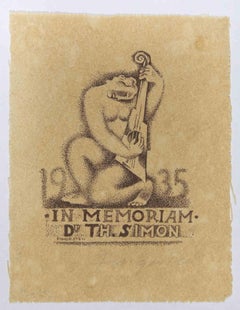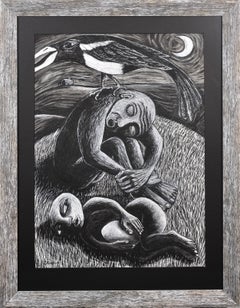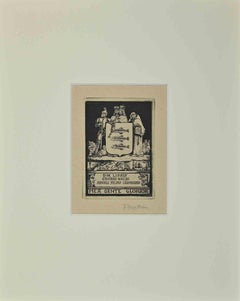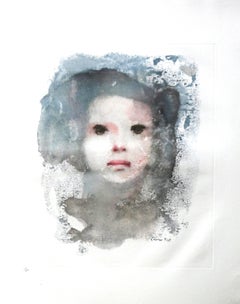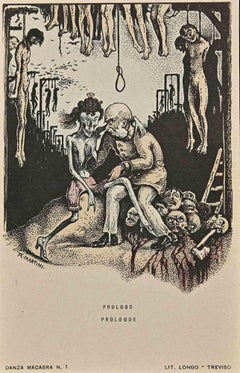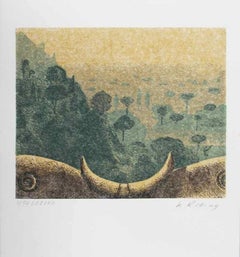Symbolist Art
to
191
572
105
161
46
76
Overall Width
to
Overall Height
to
2
109
644
208
27
103
111
93
14
12
24
18
52
15
114,409
65,111
54,851
27,074
14,944
9,341
6,500
5,763
4,196
3,053
2,593
2,320
2,255
722
607
269
66
566
354
232
182
182
110
101
58
49
48
46
38
33
33
26
25
22
20
20
19
259
229
162
159
139
94
44
38
37
34
134
437
548
256
Style: Symbolist
Ex Libris - In Memoriam Dr. Th. Simon - Etching by Michel Fingesten - 1930s
Located in Roma, IT
Ex Libris - In Memoriam Dr. Th. Simon is a woodcut print created by Michel Fingesten in 1935.
Hand signed on the lower margin.
Good conditions.
Michel Fingesten (1884 - 1943) was...
Category
1930s Symbolist Art
Materials
Etching
The Thief Framed Symbolist & Expressionist Pastel Artwork Magpie Black & White
Located in Sutton Poyntz, Dorset
Julian Ruddock.
British ( b.1965 ).
The Thief.
Pastel On Paper.
Signed Lower Left.
Image size 29.1 inches x 21.3 inches ( 74cm x 54cm ).
Frame size 38.4 inches x 29.9 inches ( 97.5c...
Category
Late 20th Century Symbolist Art
Materials
Paper, Pastel
Ex Libris - Giorgio Balbi - Poesia Bellezza - Etching - Mid-20th Century
Located in Roma, IT
Ex Libris - Giorgio Balbi - Mea Gente Glorior is an Artwork realized by Alberto Martini in Mid 20th Century.
Etching.
Good conditions.
Category
Mid-20th Century Symbolist Art
Materials
Etching
Portrait de Jeune Fille Portrait of a Girl 1970 original aquatint Leonor Fini
By Leonor Fini
Located in Paonia, CO
Portrait de Jeune Fille is a haunting portrait of a young girl also known as .. Justine… she could be either fading into the distance or just materializing out of a dream state. Her hair and the air around her is in shades of pale blue and the background is the white of the paper. This is a limited edition ( 170/300) aquatint , signed in the plate. In good condition with a 1" repaired tear midway on the right border which will not show when framed.
Argentinian-born artist Leonor Fini (1907-1996) is considered one of the great female artists of the twentieth century. She moved to Paris in the early 1930’s where she spent most of her life and almost immediately formed friendships with Salvador Dali, Cartier- Bresson, Max Ernst and other intellectuals of the time. At twenty five she had her first one person show in Paris and was included in the 1936 pivotal exhibition at MOMA…Fantastic Art, Dada and Surrealism…..and that same year had an exhibition at a famous avant garde gallery in New York. Although Fini never considered herself a Surrealist she maintained close personal relationships with several members of the group. One can see how their ideology influenced her work but she remained firmly rooted in the tradition of Symbolism, Metaphysics and Italian and German Romanticism Her works can be found in most important collections of modern art around the world.
Fini was renowned as a portraitist and as a painter of erotic sexual tensions with a mysterious atmosphere. She was adamant about being independent and not belonging to any one group. She lived life on her own terms and is sometimes referred to as …..the female Dali. She was also involved with designing for fashion and creating elaborate sets for opera and theatre. As a feminist she was definitely ahead of the times. She produced the first erotic male nude...
Category
20th Century Symbolist Art
Materials
Aquatint
The European Macabre Dance N.1 - Lithograph by A. Martini - 1915
Located in Roma, IT
The European Macabre Dance N.1 is an hand-colored lithograph, from the Series "La Danza Macabra Europea" illustrated by Alberto Martini (Oderzo, 1876 – Milan, 1954) in 1915.
Signed...
Category
1910s Symbolist Art
Materials
Lithograph
Tuscan Landscape - Linocut by Karl Rössing - 1970s
Located in Roma, IT
Tuscan Landscape is a color linocut realized in 1970s by the Austrian artist Karl Rössing (1897-1987).
Hand-signed and numbered on the lower margin.
Edition 4.971 of 10.000.
Ver...
Category
1970s Symbolist Art
Materials
Paper, Linocut
Die Versuchung des Heiligen Antonius - Original Lithograph by A. Kubin - 1922
By Alfred Kubin
Located in Roma, IT
Die Versuchung des Heiligen Antonius is an original lithograph on simili japanese paper, realized by Alfred Kubin in 1922, Hand-signed, edition of 100 copies.
Ref.: Arnason & Wheel...
Category
1920s Symbolist Art
Materials
Lithograph
Ex Libris - Joris Verbrugge - Woodcut - Mid-20th century
Located in Roma, IT
Ex Libris - Joris Verbrugge is a Modern Artwork realized in Mid 20th Century.
B/W woodcut on paper.
The work is glued on cardboard.
Total dimensions: 20x 15 cm.
Excellent co...
Category
Mid-20th Century Symbolist Art
Materials
Woodcut
$114 Sale Price
40% Off
Ex Libris W.C. Schouten - Woodcut - Mid 20th Century
Located in Roma, IT
Ex Libris W.C. Schouten is a Modern Artwork realized in mid 20th Century.
B/W woodcut on paper.
The work is glued on cardboard.
Total dimensions: 20x 15 cm.
Mint conditions...
Category
Mid-20th Century Symbolist Art
Materials
Woodcut
$128 Sale Price
40% Off
Ex Libris Kortryk Vlaanderen - Woodcut - Mid 20th Century
Located in Roma, IT
Ex Libris Kortryk Vlaanderen is a Modern Artwork realized in Mid 20th Century.
Colored woodcut on paper.
The work is glued on cardboard.
Total dimensions: 20 x 14.5 cm.
Min...
Category
Mid-20th Century Symbolist Art
Materials
Woodcut
$143 Sale Price
40% Off
The European Macabre Dance N.12 - Lithograph by A. Martini - 1915
Located in Roma, IT
The European Macabre Dance N.12 is a hand-colored lithograph, from the Series "La Danza Macabra Europea" illustrated by Alberto Martini (Oderzo, 1876 – Milan, 1954) in 1915.
Origina...
Category
1910s Symbolist Art
Materials
Lithograph
Non Fugimus Tempestatibus. Ex Libris- L.H. A. Beels - Woodcut - Mid-20th Century
Located in Roma, IT
Non Fugimus Tempestatibus. Ex Libris - L.H. A. Beels is a Modern Artwork realized in mid 20th Century.
Ex Libris. Coloured woodcut on paper.
The work is glued on cardboard.
...
Category
Mid-20th Century Symbolist Art
Materials
Woodcut
Ex Libris Matea Serra - Woodcut Print - Mid-20th Century
Located in Roma, IT
Ex Libris Matea Serra is an Artwork, woodcut print on ivory-colored paper. The work is glued on cardboard.
Total dimensions: 21 x 15.5 cm.
The artwork represents a daily scene, thr...
Category
Mid-20th Century Symbolist Art
Materials
Woodcut
Knight and Lady - Original Woodcut Print - Early 20th Century
Located in Roma, IT
Cavalier and Lady is an original woodcut print on paper, realized by unknown Artist of the early 20th Century.
Hand-signed on lower right, illegible.
Included a Passepartout: 25 x...
Category
Early 20th Century Symbolist Art
Materials
Woodcut
Ex Libris - Mina Pàscoa - Woodcut - Mid 20th Century
Located in Roma, IT
Ex Libris - Mina Pàscoa is a Modern Artwork realized in Mid 20th Century.
Ex Libris. B/W woodcut on ivory paper.
The work is glued on cardboard.
Total dimensions: 21x 15.5 cm.
E...
Category
Mid-20th Century Symbolist Art
Materials
Woodcut
Die Elixiere des Teufels - Rare Book Illustrated by Hugo Steiner-Prag - 1907
Located in Roma, IT
Die Elixiere des Teufels is an original modern rare book written by Hoffman E.T.A. (24 January 1776 – 25 June 1822) and illustrated by Hugo Steiner-Prag (Prague, 1880 - New York, 194...
Category
Early 20th Century Symbolist Art
Materials
Paper, Photogravure
John A Self Portrait Framed Original Ink Drawing Modern Irish Mid-20th Century
By John Kingerlee
Located in Sutton Poyntz, Dorset
John Kingerlee.
Irish ( b.1936 ).
John, 1967. A Self-Portrait.
Ink On Paper.
Signed & Dated Lower Left.
Image size 11 inches x 8.5 inches ( 28cm x 21.5cm ).
Frame size 15 inches x ...
Category
Mid-20th Century Symbolist Art
Materials
Paper, Ink
Les Pavots Noirs - Phototype after Odilon Redon - 1923
By Odilon Redon
Located in Roma, IT
Les Pavots Noirs is a phototype reproduction realized after Odilon Redon.
They belong to the suite "Odilon Redon Peintre, Dessinateur et Graveur", published by Henri Felury in 1923...
Category
1920s Symbolist Art
Materials
Photogravure
Illustration from the series "Les Fleurs du Mal" after Odilon Redon - 1923
By Odilon Redon
Located in Roma, IT
Illustration from the series "Les Fleurs du Mal" is an etching print realized after Odilon Redon and published by Henri Felury in 1923.
Monogrammed on the plate.
Good conditions, w...
Category
1920s Symbolist Art
Materials
Etching
Die Zisterne - Vintage Héliogravure by Franz von Bayros - 1921 ca.
Located in Roma, IT
Die Zisterne is a black and white héliogravure on cream-colored cardboard realized by Choisy Le Conin, pseudonym of Franz Von Bayros (Agram, 1866 – Vienna, 1924).
From Mappe, a port...
Category
1920s Symbolist Art
Materials
Engraving
Portrait - Lithograph after Odilon Redon - 1923
By Odilon Redon
Located in Roma, IT
Portrait is a lithograph realized after Odilon Redon.
They belong to the suite "Odilon Redon Peintre, Dessinateur et Graveur", published by Henri Felury in 1923.
Good conditions, ...
Category
1920s Symbolist Art
Materials
Lithograph
Illustration from the Series "Les Fleurs du Mal" after Odilon Redon - 1923
By Odilon Redon
Located in Roma, IT
Illustration from the series "Les Fleurs du Mal" is an etching print realized after Odilon Redon and published by Henri Felury in 1923.
Monogrammed on the plate.
Good conditions.
...
Category
1920s Symbolist Art
Materials
Lithograph
Ex Libris Fernando Alb. Junior Marques Figueira Da Foz-Woodcut-Mid 20th Century
Located in Roma, IT
Ex Libris Fernando Alb. Junior Marques Figueira Da Foz is a Modern Artwork realized in Mid 20th Century.
Ex Libris. Coloured woodcut on paper.
The work is glued on cardboard.
...
Category
Mid-20th Century Symbolist Art
Materials
Woodcut
Erfüllung - Vintage Héliogravure by Franz von Bayros - 1921 ca.
Located in Roma, IT
Erfüllung is a black and white héliogravure on cream-colored cardboard realized by Choisy Le Conin, pseudonym of Franz Von Bayros (Agram, 1866 – Vienna, 1924).
From Mappe, a portfol...
Category
1920s Symbolist Art
Materials
Engraving
Figure of Woman - Woodcut by Michel Fingesten - 1936
Located in Roma, IT
Figure of Woman is a woodcut print by Michel Fingesten, realized in 1936.
Hand signed, included a white cardboard passpartout (30x24 cm).
In excellent conditions: As good as new.
Michel Fingesten (1884 - 1943) was a Czech painter and engraver of Jewish origin. He is considered one of the greatest Ex Libris artists in history. From an Austrian weaver father and a Jewish mother...
Category
Early 20th Century Symbolist Art
Materials
Woodcut
Ex Libris Joaquin Alvarez Calvo - Woodcut Print - Mid-20th Century
Located in Roma, IT
Ex Libris Joaquin Alvarez Calvo is a woodcut print on ivory-colored paper. The work is glued on cardboard.
Total dimensions: 21 x 15.5 cm.
The artwork represents a figure who holds...
Category
Mid-20th Century Symbolist Art
Materials
Woodcut
$128 Sale Price
40% Off
"Warning" abstract acrylic paint on linen panel 95x62cm 2022
Located in Saint Pol de Léon, Bretagne
"Warning" abstract acrylic paint on linen panel 95x62cm 2022
Looking at the peaceful sky of Brittany came to me the need to paint a possible threat that could fall on us.
Something ...
Category
2010s Symbolist Art
Materials
Marble
$4,579 Sale Price
20% Off
The European Macabre Dance N.5 - Lithograph by A. Martini - 1915
Located in Roma, IT
The European Macabre Dance N.5 is a hand-colored lithograph, from the Series "La Danza Macabra Europea" illustrated by Alberto Martini (Oderzo, 1876 – Milan, 1954) in 1915.
Signed ...
Category
1910s Symbolist Art
Materials
Lithograph
Ex Libris - W. Talbot - Etching by Michel Fingesten - 1930s
Located in Roma, IT
Ex Libris- W. Talbot is an Etching print created by Michel Fingesten.
Hand Signed on the lower right margin.
The work is glued on cardboard.
Total dimensions: 24.5 x 17.5 cm.
Ve...
Category
1930s Symbolist Art
Materials
Etching
$534 Sale Price
20% Off
Ex Libris - Albert Delage - Etching by Michel Fingesten - 1930s
Located in Roma, IT
Ex Libris - Albert Delage is an Etching print created by Michel Fingesten.
Hand signed on the lower margin.
Good conditions.
Michel Fingesten (1884 - 1943) was a Czech painter an...
Category
1930s Symbolist Art
Materials
Etching
$321 Sale Price
40% Off
The European Macabre Dance N.37 - Lithograph by A. Martini - 1915
Located in Roma, IT
The European Macabre Dance N.37 is a hand-colored lithograph, from the Series "La Danza Macabra Europea" illustrated by Alberto Martini (Oderzo, 1876 – Milan, 1954) in 1915.
Signed...
Category
1910s Symbolist Art
Materials
Lithograph
Figure - Original Etching by Michel Fingesten - Early 20th Century
Located in Roma, IT
Figure is an original etching artwork realized by Fingesten.
The state of preservation is good except for a line of folding.
Stamp on the rear "MICHEL FINGESTEN"
The artwork repre...
Category
Early 20th Century Symbolist Art
Materials
Etching
Au Pays de la Vierge - Original Woodcut Print by Pierre-Eugène Vibert - 1897
Located in Roma, IT
Au pays de la Vierge is an original artwork realized by French artist Pierre Eugène Vibert .
It's an original woodcut print, signed on plate on...
Category
19th Century Symbolist Art
Materials
Woodcut
Ex Libris - H. Malz - Etching by Michel Fingesten - 1930s
Located in Roma, IT
Ex Libris - H. Malz is a colored Woodcut print created by Michel Fingesten.
Hand Signed on the lower right margin.
The artwork is glued on cardboard.
Total dimensions: 29 x 22.5...
Category
1930s Symbolist Art
Materials
Etching
Women and Dagger - Woodcut by Michel Fingesten - 1936
Located in Roma, IT
Women and Dagger (ex Libris) is a woodcut print by Michel Fingesten, in 1936.
Hand signed with pencil, included a white cardboard passpartout (30x24 cm).
In excellent conditions: As good as new.
Michel Fingesten (1884 - 1943) was a Czech painter and engraver of Jewish origin. He is considered one of the greatest Ex Libris artists in history. From an Austrian weaver father and a Jewish mother from Trieste. At 16 he studied at the Vienna Academy, together with Oskar Kokoschka. From 1902 to 1906 he wandered around America, and then Australia, before arriving in Palermo in 1907. He went up the peninsula via Trieste and returning to Germany, first settling in Munich in Franz von Stuck's studio, practicing caricature and small format graphics and then in Berlin.
In 1913 he began to record. He returned to Italy in 1935 to visit his maternal relatives from Trieste and remained there because of the racial persecutions to which the Jews in Silesia were subject, settling in Milan. In this period he recorded about 500 exlibris. On 9 October 1940 he was arrested and interned as a foreigner in the camp of Civitella del Tronto and then of Ferramonti, (Cosenza) from November 1941 and will be accused by the Nazis of having painted degenerate art ("Entartete Kunst...
Category
Early 20th Century Symbolist Art
Materials
Woodcut
The European Macabre Dance N.7 - Lithograph by A. Martini - 1915
Located in Roma, IT
The European Macabre Dance N.7 is a hand-colored lithograph, from the Series "La Danza Macabra Europea" illustrated by Alberto Martini (Oderzo, 1876 – Milan, 1954) in 1915.
Signed on the plate, Original Edition.
Published by Domenico Longo, Treviso.
Handcolored lithographic postcards.
Very good conditions.
Alberto Martini (Oderzo, 1876 - Milan, 1954); was an Italian draftsman, painter, engraver and illustrator, forerunner of the surrealist movement...
Category
1910s Symbolist Art
Materials
Lithograph
Ex Libris - Paul Valery - Etching by Michel Fingesten - 1930s
Located in Roma, IT
Ex Libris - Paul Valery is an Etching print realized by Michel Fingesten.
Hand Signed in the lower right margin.
Good conditions.
Michel Fingesten (1884 - 1943) was a Czech painte...
Category
1930s Symbolist Art
Materials
Etching
Ex Libris - Nina Tosi - Woodcut by Michel Fingesten - 1930s
Located in Roma, IT
Ex Libris - Nina Tosi is a woodcut print created by Michel Fingesten.
Hand Signed on the lower right margin.
Good conditions.
Michel Fingesten (1884 - 1943) was a Czech painter a...
Category
1930s Symbolist Art
Materials
Woodcut
$332 Sale Price
20% Off
Ex Libris - Etching by Michel Fingesten - 1937
Located in Roma, IT
Ex Libris is an Etching print created by Michel Fingesten in 1937.
Hand Signed on the lower right margin.
The work is glued on cardboard.
Total dimensions: 32.5 x 24 cm.
Very Go...
Category
1930s Symbolist Art
Materials
Etching
$553 Sale Price
20% Off
Ex Libris Dr. Walter Vogel - Etching by Michel Fingesten - 1923
Located in Roma, IT
Ex Libris - Dr. Walter Vogel is an Etching print created by Michel Fingesten, in 1923.
Hand Signed and dated on the right margin.
Good conditions except some foxings.
Michel Fi...
Category
1930s Symbolist Art
Materials
Etching
$524 Sale Price
20% Off
Ex Libris - Constant Van Dyk - Lithograph by M. Mentink - 1944
Located in Roma, IT
Ex Libris - Constant Van Dyk is a Modern Artwork realized in 1944, by M. Mentink, from Holland.
Ex Libris. Lithograph on ivory paper. Signed on plate and dat...
Category
1940s Symbolist Art
Materials
Lithograph
Ex Libris - M.R. - Woodcut by Michel Fingesten - 1930s
Located in Roma, IT
Ex Libris M.R. is a Woodcut print created by Michel Fingesten.
Hand Signed on the lower right margin.
Very Good condition.
Michel Fingesten (1884 - 1943) was a Czech painter and ...
Category
1930s Symbolist Art
Materials
Woodcut
$362 Sale Price
20% Off
Ex Libris Ex Bibliotheca Macabrum - Etching by Michel Fingesten - 1939
Located in Roma, IT
Ex Libris - Ex Bibliotheca Macabrum is an Etching print created by Michel Fingesten in 1939.
Good conditions.
Michel Fingesten (1884 - 1943) was a Czech painter and engraver of Je...
Category
1930s Symbolist Art
Materials
Etching
$534 Sale Price
20% Off
Ex Libris - Mantero - Etching by Michel Fingesten - 1937
Located in Roma, IT
Ex Libris - Mantero is an Etching print created by Michel Fingesten in 1937.
Signed in plate and dated on the lower right margin.
Good conditions except some foxings that doesn't af...
Category
1930s Symbolist Art
Materials
Etching
$429 Sale Price
20% Off
Ex Libris-André de Raynal-Ex Biblioteca Macabru- Etching by M. Fingesten - 1937
Located in Roma, IT
Ex Libris - André de Raynal - Ex Biblioteca Macabrum is an Etching print created by Michel Fingesten.
Hand Signed and dated on the lower margin.
Good conditions.
Michel Fingesten...
Category
1930s Symbolist Art
Materials
Etching
Ex Libris - Gianni Mantero - Ex Musicis - Etching by Michel Fingesten - 1930s
Located in Roma, IT
Ex Libris - Gianni Mantero -Ex Musicis is an Etching print created by Michel Fingesten.
Hand Signed on the lower margin.
Good conditions.
Michel Fingesten (1884 - 1943) was a Cze...
Category
1930s Symbolist Art
Materials
Etching
Ex Libris - Gianni Mantero - Etching by Michel Fingesten - 1937
Located in Roma, IT
Ex Libris - Gianni Mantero is an Etching print created by Michel Fingesten in 1937.
Signed on plate and dated on the lower right margin.
Good conditions except some foxings that ...
Category
1930s Symbolist Art
Materials
Etching
$553 Sale Price
20% Off
Ex Libris - Mantero - Melanconico-Allegro - Etching by Michel Fingesten - 1930s
Located in Roma, IT
Ex Libris - Mantero - Melanconico-Allegro is an Etching print created by Michel Fingesten.
Hand Signed on the lower margin.
Good conditions.
Michel Fingesten (1884 - 1943) was a C...
Category
1930s Symbolist Art
Materials
Etching
Ex Libris - G.M. Van Wees, Venezia - Etching by Michel Fingesten - 1930s
Located in Roma, IT
Ex Libris - G.M. Van Wees, Venezia is an Etching print created by Michel Fingesten.
Hand signed on the lower margin. Numbered on the left corner ex. 95/150
Good conditions except ...
Category
1930s Symbolist Art
Materials
Etching
Ex Libris - Sammelt und Briefmarken - Etching by Michel Fingesten - 1930s
Located in Roma, IT
Ex Libris -Sammelt und Briefmarken is a woodcut print created by Michel Fingesten.
Hand signed on the lower margin.
Good conditions.
Michel Fingesten (1884 - 1943) was a Czech pa...
Category
1930s Symbolist Art
Materials
Etching
Illustration from the series "Les Fleurs du mal" - Etching After O. Redon
By Odilon Redon
Located in Roma, IT
Monogram of the artist on plate. Edition of 150 copies. One of the 50 H.C.copies in Roman Numerals. This print is one of the illustrations realized by Odilon Redon for an important e...
Category
1920s Symbolist Art
Materials
Etching
Illustration from the series "Les Fleurs du Mal" after Odilon Redon - 1923
By Odilon Redon
Located in Roma, IT
Illustration from the series "Les Fleurs du Mal" is an etching print realized after Odilon Redon and published by Henri Felury in 1923.
Monogrammed in the plate.
Good conditions.
...
Category
1920s Symbolist Art
Materials
Lithograph
Profil De Lumière - Lithograph after Odilon Redon - 1923
By Odilon Redon
Located in Roma, IT
Profil De Lumière is a lithograph realized after Odilon Redon.
It belongs to the suite "Odilon Redon Peintre, Dessinateur et Graveur", published by Henri Felury in 1923.
Good cond...
Category
1920s Symbolist Art
Materials
Lithograph
Harmonie - Héliogravure by Franz von Bayros - 1920s
Located in Roma, IT
"Harmonie" is an original Black and white héliogravure on cream-colored cardboard realized by Choisy Le Conin, pseudonym of Franz Von Bayros (Agram, 1866 – Vienna, 1924).
From Mappe...
Category
1920s Symbolist Art
Materials
Engraving
Cupid and Motifs - Woodcut Print - Early 20th century
Located in Roma, IT
Cupid and Motifs is a woodcut print realized by the Anonymous artist in the early 20th century.
Good conditions with slight foxing.
Beautiful tiny and delicate artwork realized by ...
Category
Early 20th Century Symbolist Art
Materials
Woodcut
$143 Sale Price
40% Off
Der Golem. Prager Phantasien - Rare Book Illustrated by Hugo Steiner-Prag - 1916
Located in Roma, IT
Der Golem. Prager Phantasien is an original modern rare book written by Gustav Meyrink, pseudonym of Gustav Meyer (Wien, January 19, 1868 - Starnberg, December 4, 1932) and illustrated by Hugo Steiner-Prag (Prague, 1880 - New York, 1945) in 1916.
Original Edition.
300 numbered and signed copies.
Published by Kurt Wolff verlag, Leipzig.
Format: In Folio.
The book includes an original Portfolio with 25 Lithographs.
Mint conditions.
Hugo Steiner-Prag (Prague, 1880 - New York, 1945); he was an artist and illustrator. In his adolescence, he took private art lessons and was a member of Jung Prag, a group of young artists fascinated by mysticism. His formal artistic career began at age seventeen when he enrolled at the Prague Academy of the Arts, Prager Kunstakadmie, in 1897. He continued his education in Munich, Germany at the Royal Academy of Fine Arts, Königliche Akademie der Bildenden Künste. It was here Steiner added “Prag'' to his last name in recognition of his home city and to help distinguish his name from other artists. The Leo Baeck Institute has a vast collection of Steiner-Prag’s illustrations and personal mementos from throughout his entire career. Viewers can appreciate his beautifully drawn city scenes and mythical creatures, photographs, set designs, artistic instruments, and certificates of achievement. In 1916, Steiner-Prag illustrated Der Golem by Gustav Meyrink. The golem...
Category
Early 20th Century Symbolist Art
Materials
Paper, Photogravure
Triumph der Salome - Vintage Héliogravure by Franz von Bayros - 1921 ca.
Located in Roma, IT
Triumph der Salome is a black and white héliogravure on cream-colored cardboard realized by Choisy Le Conin, pseudonym of Franz Von Bayros (Agram, 1866 – Vienna, 1924).
From Mappe, ...
Category
1920s Symbolist Art
Materials
Engraving
Métiers des Hommes - Rare Book Illustrated by Kurt Seligmann - 1936
Located in Roma, IT
Métiers des Hommes is an Original Rare book written by Pierre Courthion (1902-1988) and illustrated by Kurt Seligmann (Basel, 1900 - Middletown, 1961) in 1936.
Original Edition.
Pu...
Category
1920s Symbolist Art
Materials
Paper, Photogravure
$620 Sale Price
20% Off
Man in Pot - Woodcut Print by Michel Fingesten - 1930s
Located in Roma, IT
Man in pot is a woodcut print realized by Michel Fingesten in 1930s.
Above the woodcut representing a man with one hand raised and fire; underneath a card with the engraver's signature and the number 86.
30x24 cm ; it includes passpartout.
Good conditions.
Michel Fingesten. of an Austrian weaver father and a Jewish mother originally from Trieste. At the age of 16 he studied at the Vienna Academy together with Oskar Kokoschka From 1902 to 1906 he wandered around America, and then Australia, to then arrive
in Palermo in 1907. He traveled up the peninsula passing through Trieste and returning to Germany, settling first in Munich in Franz von Stuck's studio, practicing caricature and small format graphics and then in Berlin.
In 1913 he began to engrave. He returned to Italy in 1935 to visit his maternal relatives from Trieste and remained there due to the racial persecutions to which the Jews in Silesia were subjected, settling in Milan. In this period he engraved about 500 exlibris
On 9 October 1940 he was arrested and interned as a foreigner in the camp of Civitella del Tronto and then of Ferramonti (Cosenza) from November 1941 and will be accused by the Nazis of having painted degenerate art ("Entartete Kunst...
Category
1930s Symbolist Art
Materials
Woodcut
Ex Libris - Wilhem Vaneekhout - Woodcut - Mid-20th century
Located in Roma, IT
Ex Libris - Wilhem Vaneekhout is a Modern Artwork realized in Mid 20th Century.
Ex Libris. Colored woodcut on paper.
The work is glued on cardboard.
Total dimensions: 20x 15 ...
Category
Mid-20th Century Symbolist Art
Materials
Woodcut
$143 Sale Price
40% Off
Symbolist art for sale on 1stDibs.
Find a wide variety of authentic Symbolist art available for sale on 1stDibs. Works in this style were very popular during the 21st Century and Contemporary, but contemporary artists have continued to produce works inspired by this movement. If you’re looking to add art created in this style to introduce contrast in an otherwise neutral space in your home, the works available on 1stDibs include elements of orange, blue, green, red and other colors. Many Pop art paintings were created by popular artists on 1stDibs, including Michel Fingesten, Abel Pann, Franz von Bayros (Choisi Le Conin), and Ferdinand Hodler & R. Piper & Co.. Frequently made by artists working with Paint, and Oil Paint and other materials, all of these pieces for sale are unique and have attracted attention over the years. Not every interior allows for large Symbolist art, so small editions measuring 1.58 inches across are also available. Prices for art made by famous or emerging artists can differ depending on medium, time period and other attributes. On 1stDibs, the price for these items starts at $55 and tops out at $378,675, while the average work sells for $863.
Still Thinking About These?
All Recently ViewedMore Ways To Browse
Mauritz Lindstrom
Maximillien Luce
Michael Budden Central Park
Midcentury Matador Paintings
Mike Wright
Miracle On Ice
Mississippi River Painting
Monarch Of The Glen Painting
Moroccan Paintings Essaouira
Morpho Butterfly Art
Mount Tamalpais
Murray Dessner
Native American Oklahoma
New England Barn
New Orleans Jazz Poster
Niagara Falls Oil
Oil Painting By Alice
Oil Painting Willow Tree
